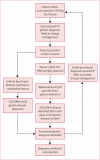Whole-genome sequencing for identification of Mendelian disorders in critically ill infants: a retrospective analysis of diagnostic and clinical findings
- PMID: 25937001
- PMCID: PMC4479194
- DOI: 10.1016/S2213-2600(15)00139-3
Whole-genome sequencing for identification of Mendelian disorders in critically ill infants: a retrospective analysis of diagnostic and clinical findings
Abstract
Background: Genetic disorders and congenital anomalies are the leading causes of infant mortality. Diagnosis of most genetic diseases in neonatal and paediatric intensive care units (NICU and PICU) is not sufficiently timely to guide acute clinical management. We used rapid whole-genome sequencing (STATseq) in a level 4 NICU and PICU to assess the rate and types of molecular diagnoses, and the prevalence, types, and effect of diagnoses that are likely to change medical management in critically ill infants.
Methods: We did a retrospective comparison of STATseq and standard genetic testing in a case series from the NICU and PICU of a large children's hospital between Nov 11, 2011, and Oct 1, 2014. The participants were families with an infant younger than 4 months with an acute illness of suspected genetic cause. The intervention was STATseq of trios (both parents and their affected infant). The main measures were the diagnostic rate, time to diagnosis, and rate of change in management after standard genetic testing and STATseq.
Findings: 20 (57%) of 35 infants were diagnosed with a genetic disease by use of STATseq and three (9%) of 32 by use of standard genetic testing (p=0·0002). Median time to genome analysis was 5 days (range 3-153) and median time to STATseq report was 23 days (5-912). 13 (65%) of 20 STATseq diagnoses were associated with de-novo mutations. Acute clinical usefulness was noted in 13 (65%) of 20 infants with a STATseq diagnosis, four (20%) had diagnoses with strongly favourable effects on management, and six (30%) were started on palliative care. 120-day mortality was 57% (12 of 21) in infants with a genetic diagnosis.
Interpretation: In selected acutely ill infants, STATseq had a high rate of diagnosis of genetic disorders. Most diagnoses altered the management of infants in the NICU or PICU. The very high infant mortality rate indicates a substantial need for rapid genomic diagnoses to be allied with a novel framework for precision medicine for infants in NICU and PICU who are diagnosed with genetic diseases to improve outcomes.
Funding: Eunice Kennedy Shriver National Institute of Child Health and Human Development, National Human Genome Research Institute, and National Center for Advancing Translational Sciences.
Copyright © 2015 Elsevier Ltd. All rights reserved.
Figures



Comment in
-
Whole-genome sequencing in critically ill infants and emerging ethical challenges.Lancet Respir Med. 2015 May;3(5):333-5. doi: 10.1016/S2213-2600(15)00151-4. Epub 2015 Apr 27. Lancet Respir Med. 2015. PMID: 25937000 No abstract available.
References
-
- Couce ML, Bana A, Boveda MD, Perez-Munuzuri A, Fernandez-Lorenzo JR, Fraga JM. Inborn errors of metabolism in a neonatology unit: impact and long-term results. Pediatr Int. 2011;53:13–17. - PubMed
-
- Martin JA, Hamilton BE, Osterman MJK, Curtin SC, Mathews TJ. Births: final data for 2012. US Department of Health and Human Services; Hyattsville, MD: 2013.
Publication types
MeSH terms
Grants and funding
LinkOut - more resources
Full Text Sources
Medical
Molecular Biology Databases

